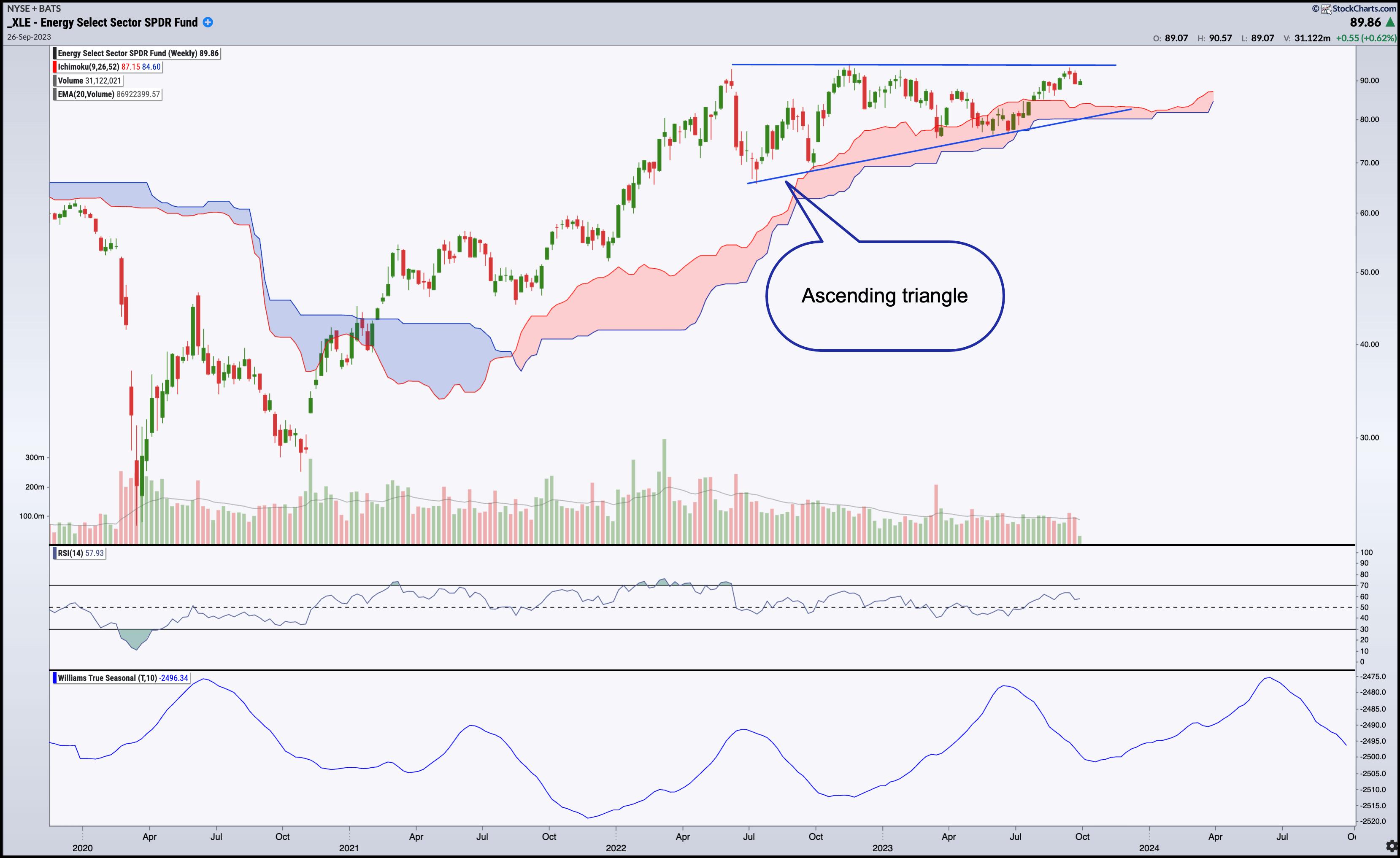TAKEAWAYS
- Energy Select Sector SPDR Fund (XLE) shows some promising technicals, signaling room for a potential climb and a strong chance for a breakout to the upside
- Technical indicators suggest that the Energy sector has a high probability of breaking out to the upside
- A breakout above its all-time high could send the energy stock higher

The Energy sector has the highest percentage of analyst buy ratings (around 64%) of all S&P sectors in the US stock market.
The kicker, however, is that these same analysts project Energy to have the smallest price increase (a mere 10.7%) among all sectors in the next 12 months.
So, is the energy sector worth buying or not? Does it have room to run, and if so, how far can it go? We can see the tailwinds (recovering fuel demand and elevated oil and gas prices), but do we see any headwinds along the way?
OPEC+'s Surprise Power Play
In an unexpected move, the oil cartel slashed oil production by a whopping 1.66 million barrels per day on April 2. This catapulted the oil price and fueled a 4.5% surge in most energy stocks.
OPEC+ aims to induce a substantial market deficit through the end of the fourth quarter 2023. The global oil market responded to the drop in supply, with crude oil futures soaring over 30% from its 2023 low (reached in March and retested in May).
In a StockCharts article last Thursday, Arthur Hill sliced into the price dynamics of the United States Oil ETF (USO), unveiling how it's breached into "oversold" territory. Now, it's recoiling from those elevated levels, taking a slight dive from its RSI-filtered peak.
But that's not the case with the Energy sector, according to its proxy, the Energy Select Sector SPDR Fund (XLE).
Energy Stocks Have Room to Run, Say (Fundamental) Analysts
Anxieties stemming from the OPEC+ production cuts caused energy stocks to jump over 15% in the abovementioned period. Crude oil futures are now hovering at $90 a barrel. Citibank forecasts the global benchmark Brent crude can surpass $100 a barrel this year. Plus, energy stocks are churning out some of the most lucrative dividends among all 11 S&P sectors. And energy companies are hesitant to axe these incentives. So, what do the technicals say? Let's look at the weekly chart of XLE (see below).

CHART 1: WEEKLY CHART OF ENERGY SELECT SECTOR SPDR FUND (XLE). A long ascending triangle, an RSI that's not in an overbought level, Williams True Seasonal indicator showing that demand for fuel could increase till summer, and an Ichimoku cloud driving higher indicates that energy stocks could rise further. Chart source: StockCharts.com. For educational purposes.
When we talk about ascending triangles, we typically refer to the pattern as it appears on the daily chart. The average ascending triangle lasts 20 days. The example above is much longer (over a year long) but it still exhibits the same market dynamics, which is bullish.
Consider the following:
- On a weekly scale (similar to what you'd find it you looked at the daily chart), XLE doesn't occupy "overbought" territory, according to the Relative Strength Index (RSI), unlike USO (which is correlated to the price of WTI crude oil futures). XLE has room to run.
- Looking at the Williams True Seasonal, XLE tends to trough toward the beginning of the year and peak in the summer, when fuel demand is at its highest.
- Plotting an Ichimoku Cloud, the Kumo, though red (meaning, bearish) and thin, is drifting upwards and serving as support.
The likelihood that XLE will break out toward the upside is high, as ascending triangles have a 17% failure rate. So, technically, you might want to wager on the upside.
But there are headwinds, not only fundamentally but technically.

CHART 2: MONTHLY CHART OF XLE. If XLE breaks above the 2008 high, it could reach or break above its all-time high of $101.32. Chart source: StockChartsACP. For educational purposes.
Current resistance happens to coincide with the 2008 highs. And should XLE break above it, it also has to clear its all time high, reached in 2014, of 101.32. Will it break above this without a longer-term correction?
The Bottom Line
The Energy sector holds a strong 64% of analyst buy ratings, dwarfing all other sectors and flashing a bullish signal, yet analysts project a mere 10.7% price increase in the next 12 months. Thanks to OPEC+'s slash in oil production, the sector has seen a sharp surge, with attractive dividend yields on the table. But is it a siren song for investors? The Energy Select Sector SPDR Fund (XLE) shows some promising technicals, signaling room for a potential climb and a strong chance for a breakout to the upside. But it may also be treading on thin ice, facing formidable headwinds ahead.
Geopolitics holds the wild cards here. There's likely some upside in the near term. But what happens afterwards can send you into a spin. Be prepared for anything and be ready to shift direction if necessary.

Disclaimer: This blog is for educational purposes only and should not be construed as financial advice. The ideas and strategies should never be used without first assessing your own personal and financial situation, or without consulting a financial professional.
Happy charting!
